Bob Newton and Chris Economaki: legends, men who changed the face of racing
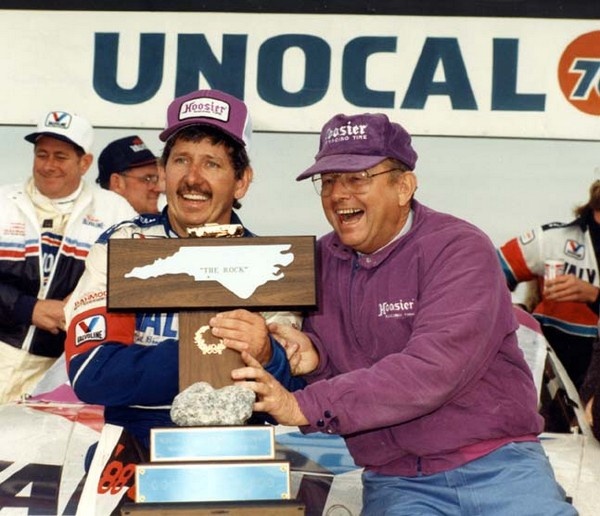
Hoosier Tire boss Bob Newton celebrating a breakthrough NASCAR victory with Neil Bonnett (Photo: Hoosier Tire)
By Mike Mulhern
mikemulhern.net
DOVER, Del.
First, Bob Newton, the shrewd and wily Hoosier Tire boss, who shook up NASCAR racing by daring to challenge giant Goodyear, in 1988-1989 and again in 1994.
Then Chris Economaki, the legendary motorsports journalist, whose sharp wit and a Howard Cosell 'tell it like it really is' attitude didn't always set well with the racers he would interview.
Two giants of this sport, passing on this week.
...and, oh, the tales those two could tell....
Far from being a sad Friday at the track, it was a time to reflect and laugh, and laugh so hard, at two men who helped make this sport what it is today.
Neither man was shy nor bashful either. They both loved the spotlight, and did a heck of a lot in it too.
And they'd go nose-to-nose in a heartbeat.
Newton, 85, died Wednesday. Economaki, 91, died Friday.
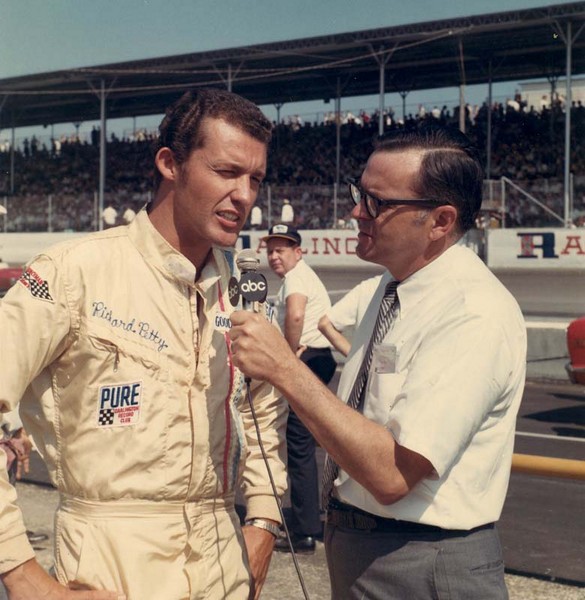
Ah, we were all young once, weren't we? Richard Petty (L) and Chris Economaki, at Darlington Raceway. Can you say when? (Photo: NSSN)
When Newton, in early 1988, decided to take his Indiana race tire company, a short-track powerhouse, up to the major leagues of NASCAR, he and his men were curtly dismissed by stock car veterans. But Newton quickly showed he meant business. Morgan Shepherd won the pole at Richmond, the tour's second event, on Hoosiers, and Neil Bonnett then won the race on Hoosiers...and Bonnett followed that by winning again at Rockingham the next time out. And Tire Wars I was on.
With that, Bob Newton changed a major dynamic in this sport.
Goodyear quickly became much more aggressive. But in May '88 at Charlotte Motor Speedway Goodyear's tires couldn't take the heat, and the company all but withdrew from the 600. Dave Marcis, on rock-hard Daytona tires, as backups, was the only man on Goodyear.
That's when the world at large realized there was something big going on in NASCAR country.
NASCAR itself had problems dealing with things too during the tire wars. Teams found themselves having to mount up 10 race sets of Goodyears and 10 race sets of Hoosiers each Friday, before first practice, not knowing which brand might have the edge.
Throughout 1988 and early 1989 it was all high drama, and marked by numerous crashes, many hard ones, many with blown right-fronts.
Drivers even today remember the hard crashes as much as anything.
Newton finally withdrew from the field of battle late in the spring of 1989, after Goodyear debuted its new, faster radial tires.
Hoosier returned to the game in 1994 with its own radials, but Newton didn't finish the season, a victim of the economics and politics as much as anything. And the death of Neil Bonnett at Daytona that spring was a hard blow too.
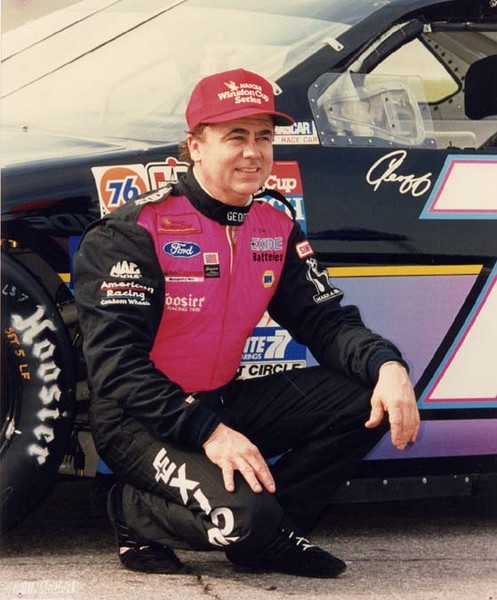
Geoff Bodine: in his Hoosier days (Photo: Hoosier Tire)
Economaki, who watched his first race in 1930, when board tracks were the thing, was the man who made the job of motorsports journalism a full-time job, and his lifetime's work. He was the first real 'beat' reporter for the sport, and still one of the best known, even 15 years or so after he 'retired.'
He covered everything from short tracks to NASCAR to Indianapolis to Formula 1.
He made his reputation as an insider, whose weekly column of bits and pieces in National Speed Sport News was typically filled with breaking news and surprising observations. Then he made his name in TV, willing to ask bold questions, which isn't always easy in this rough-and-tumble sport.
Economaki's voice and style were unique.
Economaki, interviewing Ayrton Senna: http://bit.ly/QAn1G4
Economaki, on the greatest driver he ever saw: http://bit.ly/SprNXq
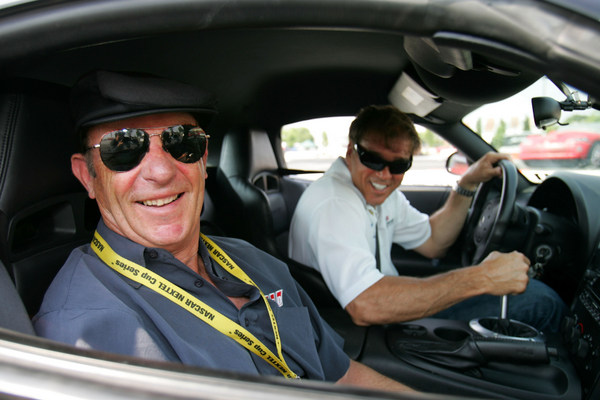
Journalist Dr. Dick Berggren. But letting Modified racer Ray Evernham take the wheel? Brave (Photo: Getty Images for NASCAR)
Dick Berggren: "Chris was the most premier auto racing journalist who ever was and ever will be. We'll never again see someone as incredibly diverse and successful at his craft.
"Chris was every bit as at home with a microphone at a local short track as he was covering the Indianapolis 500 or Daytona 500.
"Dave Despain and I had a conversation with Chris regarding how we could improve our performance. Chris said simply 'Ask a good question.'
"When I first became a full-time motorsports journalist, it was as editor of Stock Car Racing. At the time Chris' National Speed Sport News arrived on my doorstep on Thursdays, and I quickly made a habit of not answering my telephone until I'd read his column because so many of the calls that came in on Thursdays were about what he had written.
"He was so powerful and influential for so many years."
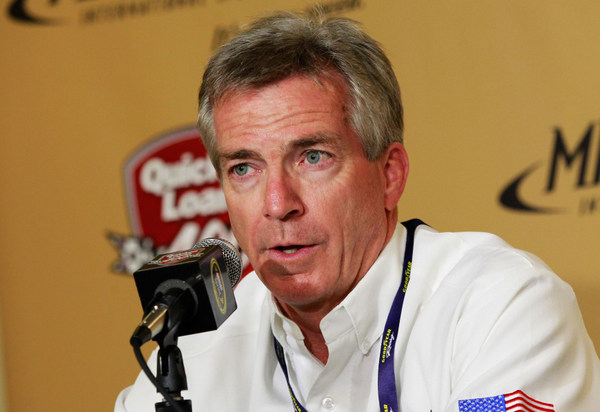
Goodyear's Greg Stucker: a veteran of Tire Wars I and Tire Wars II, and he remembers Bob Newton quite well (Photo: Getty Images for NASCAR)
Tire man Bob Newton, in his own way, helped change big things in this sport too. He certainly changed forever the way race tires are handled. And he was also a teacher about this sport, a tutor for any journalist willing to listen about the sometimes seemingly arcane world of race tires.
While the great tire wars may be the first thing that springs to mind, Newton's impact has been much more. And Hoosier is still a major player in big track racing in the U.S. It not only provides tires for the ARCA series but also builds sports car Grand-Am tires under the Continental logo...keeping its hand in the game and providing NASCAR with a nominal backup plan.
Andy Petree, both a crew chief and then car owner during the two tire wars, grimaced at the memories of those vicious race days: "I remember as a car owner that it was not a fun time, not for anybody really.
"Hoosier came in here to compete with Goodyear, and did a good job. But, boy, I'll tell you it was not fun when you have to mess with two brands of tires every weekend.
"I remember races where we had to switch brands in the middle of the race. I remember one race at Bristol in particular, where we had 10 sets of each, and had to swap brands during the race. Kind of crazy....
"But Bob was a real innovator in the tire industry...and if you look at what he's done for all forms of racing, it's incredible, really. You can't go to any short track around the country without seeing Hoosier Tire."
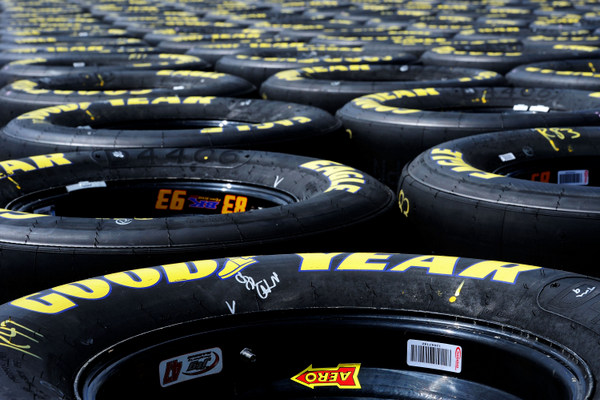
Wherever NASCAR runs.....(Photo: Getty Images for NASCAR)
Goodyear's Greg Stucker well remembers working the Rockingham race that Bonnett won back in '88.
"Neil won the race, and they cleaned our clock...and after the race Bob and I were leaving at the same time, and I congratulated him on doing a hellava job," Stucker said. "But I told him 'Don't get used to it.'"
Stucker laughed.
"Bob was obviously more aggressive on compounding and so forth. We had pretty much stabilized our line (prior to Hoosier's entry), partly at the request of NASCAR and the racers. And he came in with something more aggressive and very competitive.
"And we reacted.
"For as small as Hoosier was back in 1988 and 1994, and not really having too much exposure to Sprint Cup and Nationwide, they developed a pretty good package and we developed a lot of respect for them.
"They made some mistakes; we made some mistakes. But it was always interesting to come to the race track and see where we stood against them."
One major result of the first Goodyear-Hoosier tire war was the development of the stock car racing radial, highlighted by Dale Earnhardt's debut in victory at North Wilkesboro. "Basically we lapped Rusty (Wallace, one of Hoosier's lead drivers) before a gas stop," Stucker recalled. "When he was down a lap in 70 laps, that told the tale."
Newton withdrew from NASCAR a few weeks later. He did return in 1994 but wasn't that competitive the second time around, particularly with forces allied against him.
One of many legacies is NASCAR's 'sole supplier' contract with Goodyear, precluding any rival tire maker from coming into the sport.
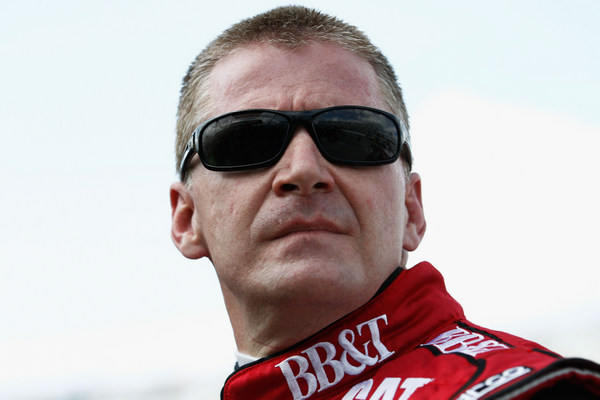
Jeff Burton: a Hoosier back when (Photo: Getty Images for NASCAR)
While most drivers stayed loyal to Goodyear, Newton found a daring few willing to try his stuff -- among them Jeff and Ward Burton, Geoff Bodine, and Lake Speed.
"Bob Newton was a racer," Jeff Burton said. "And we did a lot of testing, a lot of tire testing. They really put a lot of effort into it. And you have to admire them for that.
"Bob came into NASCAR to win. He wanted to build quality tires; he wanted to do it the right way. He came in with the right intentions.
"Ultimately it probably wasn't good for the sport overall, to have two tire manufacturers. But it did change the dynamics of a lot of stuff.
"It did make Goodyear have to get more aggressive in its tire compounds.
"But it eventually became a big (financial) draw on Bob's company, because they had to bring enough tires in to be able to supply the entire field."
Even though typically only half a dozen drivers were 'Hoosier drivers,' the rest sticking generally with Goodyear, NASCAR changed the rules eventually to require both tire makers to bring enough tires for all 43 teams each weekend....some 3,000 tires each, even if only a fraction of those would actually be used. And the dynamic of the tire war was that last week's tires were outdated as soon as that race was over.....
"Hoosier was losing a lot of money, but Bob kept going and going...until eventually he had to make a decision, because it was so expensive," Burton said.
"Bob was a hard racer, a racer at heart.
"I was fortunate a couple years ago to go to his park, the park he built for his community. Beautiful.
"It's a nice family...hard-core racers...and Bob was a really interesting guy. He's done a lot for racing. You go around the country and most short tracks you'll see Hoosier tires.
"In fact my son is running Hoosiers tonight at Ace Speedway (Burlington, N.C.).
"That's a demanding job, running a race tire company...because everyone has his own idea about what a race tire is supposed to be, and you can never make everybody happy."
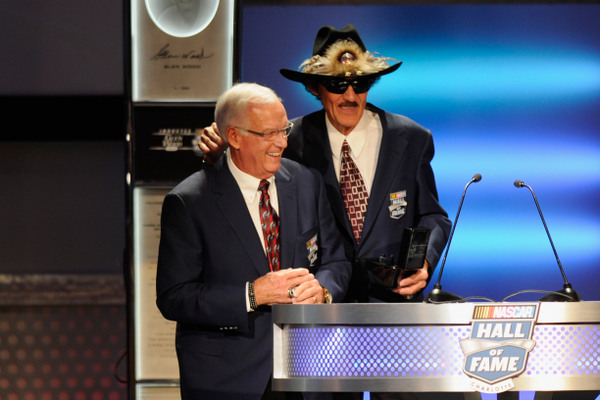
Dale Inman (L) and Richard Petty: a lot of wins together on the NASCAR circuit (Photo: Getty Images for NASCAR)
Rick Carelli, who won a lot of West Coast championships for Hoosier, and is now NASCAR spotter for Regan Smith, says Newton "was very innovative. He was an innovator. He was all about racing. And he covered every aspect of racing.
"When he had the opportunity to build radial tires (for the 1994 NASCAR return), we built 'em on the West Coast, and they had the camber already built in.
"He was just ahead of the process. His plant was state-of-the-art. And he had a 'process,' and that's a step a lot of us miss anymore.
"He had a vision, and he put his vision into action.
"In '94 he was right there, until he got run out of the sport or whatever happened."
Dale Inman, Richard Petty's long time crew chief, well remembers the battles with Hoosier. Petty was a major Goodyear spokesman, with a big sponsorship. But....
"Bob loved his tires," Inman says with a laugh, indirectly referring to some of the famous tire tricks used during the tire wars, such as different compounds with the same ID number, and different sidewall constructions also with identical ID numbers.
To counter those tricks, NASCAR finally put inspectors at the tire trucks each weekend to hand out tires at random to teams.
"We never did mess with the Hoosiers that much," Inman said. "But we were at Wilkesboro one time, and Buddy Baker was on a Hoosier deal and he was beating us on our Goodyears. So I told Richard 'Well, let's just put a set of 'em on and see how they work.'
"Gosh durn if we didn't get a telegram from Goodyear's Leo Mehl saying 'Your deal is done.'
"But Bob Newton was a racer, and he believed in his stuff."
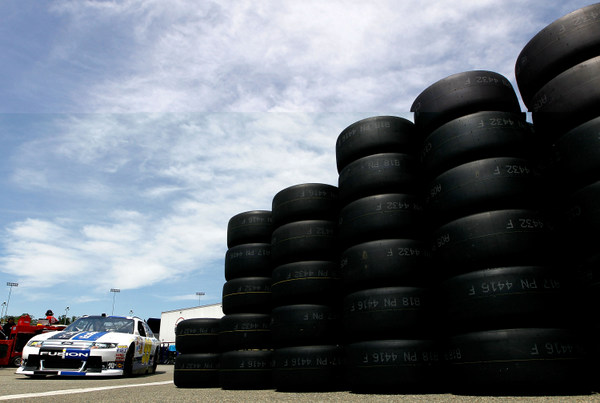
It takes a heck of a lot of tires to run a NASCAR weekend. Thousands (Photo: Getty Images for NASCAR)
© 2010-2011 www.mikemulhern.net All rights reserved.
Web site by www.webdesigncarolinas.com







Post new comment